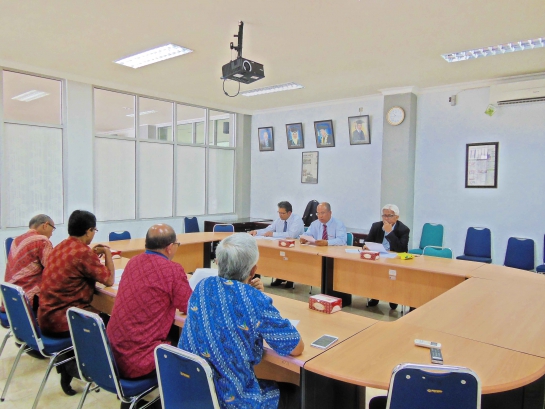
admin
CONSUMER DEMAND FOR CLEAN PRODUCTS; THE CHANGING INDONESIAN POULTRY INDUSTRY
Ian Patrick
Director, Institute for Rural Futures
University of New England, Australia
ABSTRACT
Indonesian consumers of poultry products are increasingly demanding cleaner, greener products that are not only nutritious but also produced under safe and healthy conditions. Increasing wealth, value chain development and disease scares such as Bird Flu and Newcastle disease are leading to contractor companies beginning to encourage their partners to produce a ‘cleaner’ product. A survey undertaken in three provinces (Bali, West Java and South Sulawesi) indicated that consumers would be prepared to pay between 10 and 20% above the regular price for broiler chicken, if they could be sure that these were produced on farms that met approved biosecurity standards. The ACIAR funded project then tested the market for these products in two of the provinces and found that demand for ‘Healthy Farm’ eggs and meat was indeed significant. In a supermarket in Bali during the first year of the trial, approximately 20% of the chickens sold were under the ‘Healthy Farm’ logo at an average price 12% higher than the regular product. Irrespective of the actual quality of the product, consumers were, and are prepared to pay more for poultry products produced in cleaner, greener environments. This will continue in the future.
CLIMATE CHANGE IN SOUTHEAST ASIA AND ITS RELATION WITH ADAPTIVE NATURAL RESOURCES MANAGEMENT
Nestor T. Baguinon
Professor in Forest Ecology University of the Philippines Los Banos
ABSTRACT
Southeast Asia (SEA)is rich in natural resources. Natural resources (NR)are products of evolution henceitsuniquebiota (flora and fauna). Marine natural resourcesinclude pelagic, coral reef and seagrass beds.The estuarylinks both freshwater and marine resources. At the back of mangroves and the estuary are forests.Forests vary with soil, climate, slope and elevation. Biogeographically, SEA is unique being a subset of Indoaustralasia. Itsbiota are mainly descendedfrom Gondwanian ancestors,e.g. fromIndia (e.g. Dipterocarpaceae, primates) and Australia(e.g. Podocarpaceae, parrots).However,montane/mossy forests speciesareof Eurasianorigin (e.g. Fagaceae, rodents). As background, this paper reviews SEAn climate at a millenial scope, i.e. Last Glacial Maximum (LGM) c.18,000 yrs B.P. to present. Hunting-gathering Negroids such as Australian aborigines, Papuans, Melanesians, Negritos(Philippines and Malay Peninsula) walked from Africa to archipelagic SEA,c. 50,000 yrs B.P., but about 4,000 yrs B.P.agricultural Austronesians arrived by boat irreversibly convertingforests into human settlements/farms. SEAn climates matchthe culture of ethnic groups.NR providesthem ecosystem services.Climate is thelong-term mean atmospheric condition of anygiven place, weather isits daily expression. Weather extreme is the term when the expression is abnormal, e.g. typhoons. During Glaciations, landbridges connected Continental SEA with Archipelagic SEA.It allowed overland migration of biota+humans. After the LGM, warm Interglaciationabruptly melted glaciers causing sea level rise. Sundaland became archipelagic again.Alternating Glaciation and Interglaciation is being driven by the Milankovitch Cycles. In Glaciationdeserts expand whileforestsretreat. The reverse is true for Warm Interglaciation although short drought episodescan occur as it did inAngkor Wat, Cambodia. Walker Circulation and El Nino Southern Oscillation (ENSO) together explain other droughts.Ifugao rice terraces (Payoh) coupled to natural forests (Muyong) circumventdrought uncertaintieswith forestsreliably supplyingwater.Coupled forests+farmsisboth CC adaptation (CCA) and mitigation (CCM). Drought is also a function of theso-called Little Ice Age(LIA). Stoppageof the Thermohaline Circulation initiates LIA.It occurredduringthe years1650, 1770 and 1850 after the Medieval Warming. In 1850, the Industrial Revolution was already spewing greenhouse gases (GHG)hence theAnthropogenic Climate Change (ACC) problem. Atmospheric GHGis mounting as per Mauna Loa, Hawaii Keeling Curve (1960-2015). Aside from ACC,exponential human population growth (HPG) and deforestation (DF) are closely knit problems. Under a business-as-usual scenario, ACC will destroy natural resources and makes people vulnerable to ACC extreme events. This paper presents a systems-approach solutionto ACC, HPG and DF in anylandscape (e.g. reef to ridge) under one adaptive management.It includes participatory landscape benchmarking (GIS as tool), land-use plan (coupled biodiversity corridors+agroforestry), IEC, renewable energy cooperative, M&E, fine-tuning of CCA + CCM.
Keywords: Nature, Man, Austronesian, biosphere, noosphere, anthropocentrism, alienation, anarchy, tragedy of the commons, limits to growth, IEC, capacity-building, GIS benchmark, conflict resolution, land-use plan, knowledge management, biodiversity corridors, agroforestry cooperatives, ecological covenant, adaptive/ecological governance, sustainable economics, M&E, green development fine-tuning.
Program Pascasarjana Universitas Andalas dapat kunjungan dari Pascasarjana Universitas Sains Malaysia yaitu oleh Prof. Razak, Khalid dan Prof. Isa.
Dari Program Pascasarjana Unand disambut oleh Direktur PPs Unand Prof.Dr.Ir. Rudi Febriamansyah dan dan Wakil Direktur I Prof.Dr. Syukri Arief, M.Eng.
Kunjungan ini diadakan pada hari selasa, 13 Desember 2016 yang bertempat di ruang rapat pimpinan Program Pascasarjana Universitas Andalas lantai 2.
Pembahasan dalam kunjungan ini ada salin memperkenal program studi yang ada pada Program Pascasarjana masing-masing, menjelaskan join degree dan double degree, penjelasan pasca merintis join degree Program Pascasarjana Universitas Andalas dengan GIFU University.
Prof. Razak menjelaskan bahwa MOU yang dijalin agar segera di realisasikan dan mendiskusikan program apa yang akan digulirkan oleh kedua Pascasarjana.
Prof. Isa menjelaskan perlu melakukan workshop kurikulum untuk menyamakan dan penyamaan matakuliah yang bisa dilakukan bergabung program studi pesertanya.



